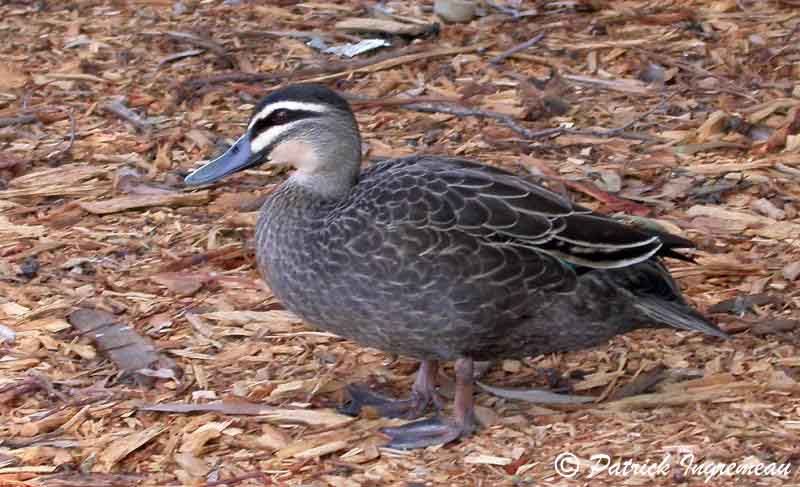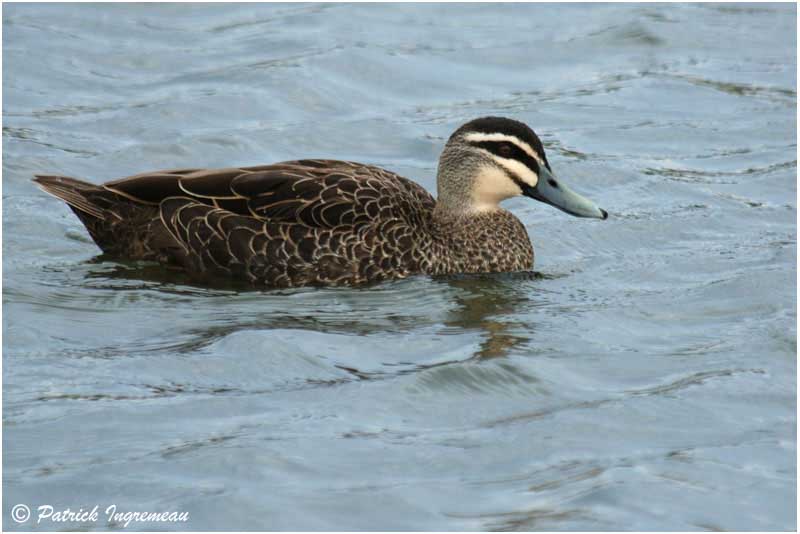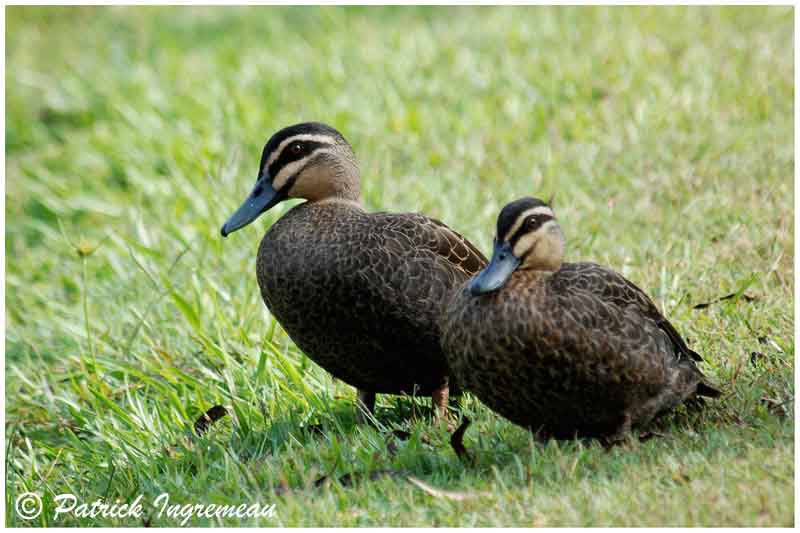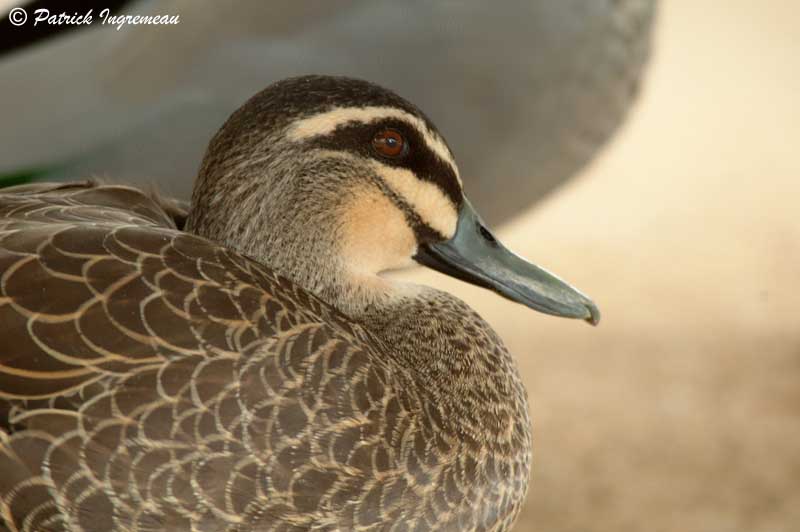
Pacific Black Duck
Anas superciliosa
Anseriforme Order – Anatidae Family
BIOMETRICS:
Length: 54-61 cm
Weight: M: 1114 g – F: 1025 g
LONGEVITY: about 2 years
DESCRIPTION:
Pacific Black Duck has same appearance in all plumages. It is a dabbling duck.

Adult has dark brown plumage. Upperwing is dark brown, with pale yellow or white tips on great coverts; secondaries are green showing an iridescent green patch on wings, with black border and yellowish or white edges.
Underparts are dark brown with yellowish-edged feathers. Underwing is white with dark flight feathers.
On the head, we can see dark brown crown and nape, conspicuous pale yellow supercilium, dark eye line from lores to ear coverts, pale yellow area from bill through cheeks to ear coverts, and dark line between cheek and upper neck. Head sides and neck are pale brownish yellow.
Bill is dark grey with paler tips and black nail. Eyes are dark brown. Legs and feet are yellowish-brown with dark webs.
Female is duller and smaller than male. She has less marking.
Juvenile is similar to adults, but facial pattern is duller. Breast and belly are more heavily streaked with yellowish-buff. It can breed at one year.
Pacific Black Duck is closely related to Mallard (Anas platyrhynchos) which has been introduced into Australia, and both species hybridize when they live together in the same range.
There are three subspecies:
A.s. superciliosa, living in New Zealand;
A.s. rogersii, living in Indonesia, New Guinea and Australia;
A.s. pelewensis, living in the Southwest Pacific Islands.

VOICE: SOUNDS BY XENO-CANTO
Pacific Black Duck male utters varied sounds, from soft “hiss” to long “quack”. Female gives loud, raucous “quack-quack-quack-quack-quack” sounds, repeated quickly in alarm.
HABITAT:
Pacific Black Duck lives in varied wet areas with mainly deep permanent swamps with dense vegetation, in waterside vegetation, flooded grasslands, fresh or brackish lagoons, streams and small ponds. It avoids sea coasts and very salted water, but it is found in tidal mudflats.
RANGE:
Pacific Black Duck lives in most parts of Indonesia, New Guinea, Australia, New Zealand and numerous islands in SW Pacific.
BEHAVIOUR:
Pacific Black Duck feeds mainly on plant matter and small crustaceans, molluscs and aquatic insects. It dabbles, plunging head and neck into water and raising its rear end out of the water. It may also feed on land, in flooded meadows. Most of the feeding is done at night.

Pacific Black Duck is often seen in pairs or in small groups, often mixed with other duck species. It may be nomadic, following rain and floods, but it is sedentary in area with plentiful water.
Breeding season may vary, according to the location, food resources and water. Ducks perform some courtship displays such as mutual preening, bobbing and wing flapping. Female often initiate these rituals. Male utters a whistle followed by a grunt during courtship displays.
Pacific Black Duck breeds from June to January in the South, and from January to April in the North.
FLIGHT:
Pacific Black Duck has strong flight. It takes off easily from water. White underwings are very conspicuous in flight.
REPRODUCTION:
Pacific Black Duck usually nests near water. Nest is hidden in tall grasses or rushes, but also in hollow in tree. Nest is made with grass, and lined with feathers.
Female lays 8 to 12 greenish eggs. Incubation lasts about 26 to 30 days, by female alone. Young can fly at 48 to 58 days of age. But only about 20% of the offspring will survive more than two years.
This species usually produces two broods per season.

DIET:
Pacific Black Duck feeds mainly on aquatic vegetation, such as shoots, seeds, tubers and roots, but it may add small crustaceans, molluscs and aquatic insects, snails and other small invertebrates. It can also feed inland in flooded meadows.
PROTECTION / THREATS / STATUS:
Pacific Black Duck is abundant and widespread in Australia and New Zealand. It seems to be more common in temperate areas.
This species is available fro recreational hunting in several parts of its range.
Fr: Canard à sourcils
All : Augenbrauenente
Esp : Anade Cejudo
Ital : Anatra nera del Pacifico
Nd : Wenkbrauweend
Russe : Австралийская чёрная кряква
Photographs by Patrick Ingremeau
TAMANDUA
Text by Nicole Bouglouan
Sources :
HANDBOOK OF THE BIRDS OF THE WORLD vol 1 by Josep del Hoyo-Andrew Elliot-Jordi Sargatal - Lynx Edicions - ISBN: 8487334105
GUIDE DES CANARDS, DES OIES ET DES CYGNES – de Steve Madge - Delachaux et Niestlé - ISBN: 2603013769
Birds in backyards (Birds Australia and Australian Museum)
BirdLife International (BirdLife International)